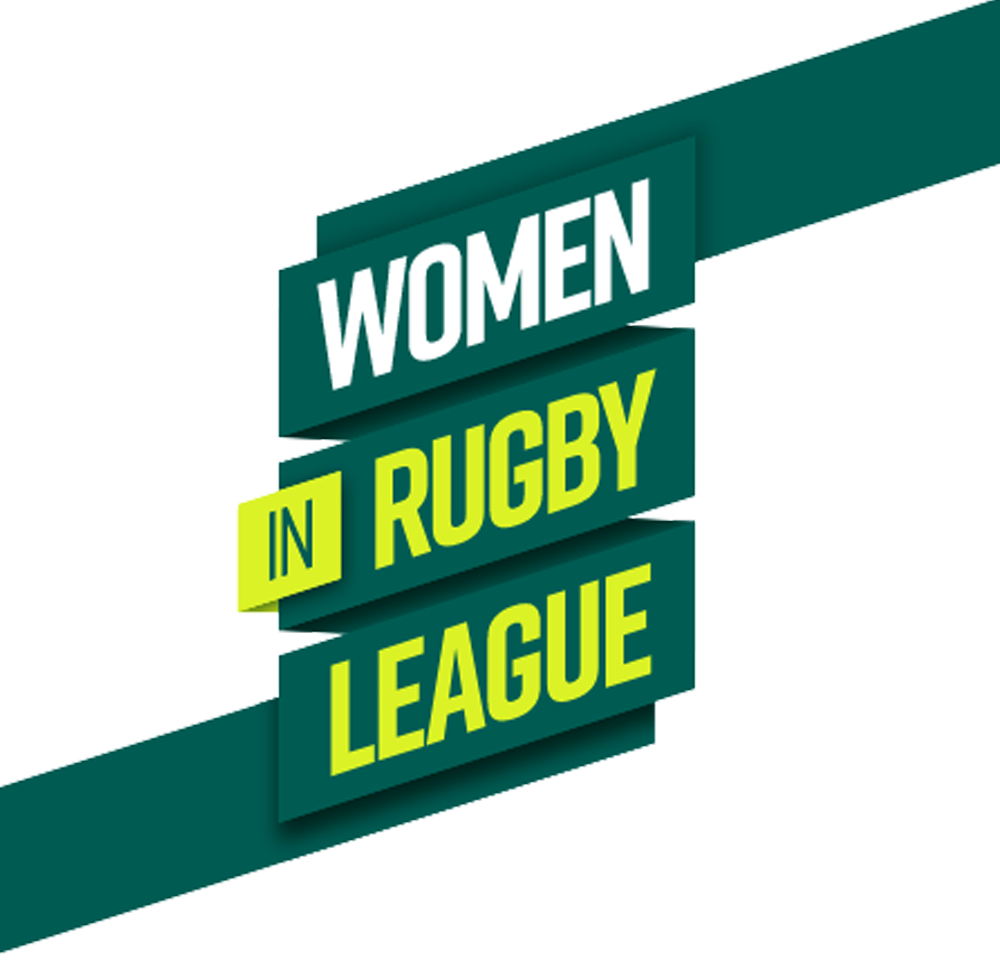









Tara Jones has made history in rugby league by becoming the first full-time female match official with the Rugby Football League (RFL). This significant milestone was announced in October 2024, marking a groundbreaking achievement in the sport’s officiating landscape.
Before transitioning to officiating, Tara Jones had a distinguished playing career. She was a standout hooker for St Helens and the England national team, earning 14 international caps and participating in the 2022 World Cup semi-finals.
Notably, she scored the first-ever try in a Women’s Challenge Cup final at Wembley in 2019.
In addition to her playing achievements, Tara began her officiating journey at the age of 12 with the Warrington Referees’ Society.
She progressed through the ranks, becoming a Grade 2 referee in early 2018 and officiating at various levels, including the Challenge Cup and Super League matches.
In April 2024, Jones made history by becoming the first woman to referee a senior men’s rugby league fixture in the northern hemisphere, officiating the League One match between Oldham and Cornwall.
Her appointment to the RFL’s full-time match officials squad in 2025 further solidified her trailblazing role in the sport

In January 2023, the Rugby Football League announced a new pyramid structure for women’s rugby league based on a long-term vision outlined in 2016, in which the Super League would sit above four regional divisions, Midlands, North, Roses, and South, who would compete for promotion to the Super League.
The WSL South had been established in 2021, and the Midlands and North leagues were launched in 2023.
The change meant that the Super League would be reduced to eight teams from 2024, with four of the teams from Group 2 in 2023 joined by clubs from the Championship as part of a new tier two league.
On 24 January, when the fixtures for the 2024 Super League season were announced, it was revealed that in 2024 the second tier would have only three leagues: Midlands, Northern and Southern, from which only the winners of the Northern and Southern Championships would meet in the National Championship Final for the chance to face the bottom side of the Super League in play-off for a chance to earn promotion.
In October 2024, Featherstone Rovers were relegated following a 34–16 defeat to Championship winners Leigh Leopards, and York Valkyrie became the first side to retain the Super League title by defeating St Helens 18–8 in the Grand Final

The Rhinos made history in late 2022 when they announced they would be the first team to provide payments to their Women’s Super League players — a move quickly supported by York Valkyrie.
In 2023, Leeds offered a win bonus for every game, along with merit-based payments for success in both the Challenge Cup and the Women’s Super League.
The club described this as the latest step toward making their women’s team a fully professional outfit, years ahead of schedule.
York Valkyrie captain Sinead Peach, vice-captain Tara-Jane Stanley, and England international Liv Wood were the first three players to sign two-year professional contracts, beginning with the 2024 season.
Wigan Warriors have committed to paying their Women’s Super League (WSL) players, aligning with the initiatives of Leeds and York.
This move underscores the club’s dedication to elevating the women’s team to a fully professional status, ensuring players are compensated for their contributions.
Huddersfield Giants have also introduced financial incentives for their women’s team. While specific details are limited, this step indicates the club’s commitment to supporting and developing the women’s game, providing players with the resources needed to excel.

2023 saw the first occasion of the Women’s Rugby League Challenge Cup being played at Wembley Stadium, prior to the men’s final.
The Women’s Challenge Cup was set up in 2012 by the Rugby Football League (RFL) to run alongside the men’s competition to give women’s rugby teams more competitive games and to give the sport a bigger profile by attaching it to the Challenge Cup.
Most teams in the first few years were community clubs and had no links to professional men’s clubs.
In 2018, the competition started to receive a much higher profile, with the final being broadcast live on the BBC Sport website.
In 2019, bookmakers Coral agreed to sponsor the competition – in addition to their sponsorship of the men’s Challenge Cup – and it was also announced that the final of the 2019 Cup would be played as part of a triple-header with the semi-finals of the men’s 2019 Challenge Cup at the University of Bolton Stadium on 27 July 2019.
The 2019 competition also saw the introduction of a new trophy commissioned by the RFL.
In 2020, the competition was suspended after the first round and later cancelled due to the COVID-19 pandemic.
In the 2021 competition, entry was restricted to the ten teams in the Super League.
The following year, the competition expanded to 16 teams (12 Super League, three Championship, and one Super League South), and a group stage was introduced with the top two teams from the four groups advancing to the quarter-final stage.

In the 1990s, women had to battle for recognition, with club games being played in New Zealand, Australia, and England. In 1993, women were banned from playing rugby league in Australia. Yet despite these barriers, the first women’s international rugby league matches began in 1995, with the first Test matches between Australia and New Zealand.
Other international competitions continued, with Great Britain touring in 1996.
Great Britain’s first officially recognised tour was to Australia in 1996, where the team played six games and won the Test series 2-1 — a feat no other team has since achieved.
Yet upon returning home, the team received no acknowledgment.
Between 1996 and 2003, the Great Britain women’s rugby league team completed five major international tours and tournaments:
For each of these tours, the players themselves were responsible for raising the majority of the necessary funds, with the Rugby Football League (RFL) providing only limited financial support.
In 2022, Great Britain and other early international teams, including those from the 2000 and 2003 World Cups, were formally recognized by the International Rugby League.
The 76 Great Britain players received their caps and Heritage numbers at the Pride of the Lionesses event at Headingley Stadium in Leeds.
Further recognition was given to the 1996 Great Britain team when in 2024 they became the first women’s team to be inducted into the Rugby League Hall of Fame.

The Rugby League Hall of Fame was established in 1988 to honour the leading players in the game. For 34 years, however, the Hall of Fame — now a small group of 41 players — excluded women, as the criteria required inductees to have played professional rugby league.
Due to historical inequalities and discrimination, women’s rugby league struggled to establish itself, playing at an amateur level with little recognition and no pay.
It was not until 2024 that female players began receiving contracts. As a result, many outstanding women who represented their country at the highest level were overlooked and excluded from this elite club.
In 2022, this injustice was addressed when the first three women — Lisa McIntosh, Brenda Dobek, and Sally Milburn — were inducted into the Hall of Fame. They were followed in 2024 by Jane Banks and Michelle Land, bringing recognition to women who had long been missing from the 130-year history that had previously only honoured male players.
Additionally, in 2022 pioneers of the Women’s game Julia Lee and Jackie Sheldon were inducted to the Rugby League Roll of Honour, which celebrates individuals who have made extraordinary contributions to rugby league both on and off the field.
The Roll of Honour recognizes a wide range of people, including players, coaches, broadcasters, journalists, and volunteers.

Due to the pandemic, the 2021 Rugby League World Cup was postponed until 2022.
CEO Jon Dutton, drawing on his experience as Operational Director of the 2013 Rugby League World Cup, delivered the tournament guided by strong values.
For the first time, the men’s, women’s, and wheelchair competitions were held concurrently, making it the most inclusive Rugby League World Cup in history.
Female and wheelchair players received participation payments for the first time, equal to those of the men’s tournament.
Standards of accommodation, transport, and training facilities were maintained consistently across all competitions, ensuring equality for all participants.

The Rugby League World Cup 9s was an international tournament played in the rugby league nines tournament.
This marked another step forward for equity in the international game. For the first time, players from the 12 men’s teams and four women’s teams participating in the World Cup Nines received equal pay of $2,000.
The inaugural World Cup 9s took place on 18 and 19 October 2019 at the Bankwest Stadium in Sydney, New South Wales, Australia.
The women’s competition was won by New Zealand, and the men’s competition by the hosts Australia.
The tournament, like the XIII’s tournament, was intended to be held every four years.
However the 2023 tournament, which was due to be held in Australia, was cancelled due to the New South Wales Government withdrawing support after the COVID-19 pandemic.

To give the sport a bigger profile, the Super League name was adopted in 2017.
The new league was still made up of community clubs, but more professional clubs entered a women’s team,
The four founding clubs were Bradford Bulls, Castleford Tigers, Featherstone Rovers and Thatto Heath Crusaders.
In the inaugural season Bradford Bulls finished top of the league before defeating Featherstone by 36–6 in the Grand Final to add to their earlier Challenge Cup success that year.
The league expanded in 2018 with Leeds Rhinos, York City Knights and Wigan Warriors joining, while St Helens took over from Thatto Heath Crusaders.
Leeds took the League Leaders’ Shield but were defeated 18–16 by Wigan in the Grand Final.
The league was expanded again to eight clubs for 2019 with the addition of Wakefield Trinity. Leeds defeated League Leaders’ Castleford by 20–12 to become champions in front of a record crowd for a Women’s Grand Final of 1,673
In 2020, the growth of the league was planned to continue with Warrington Wolves and Huddersfield Giants joining from the Championship.
The structure was also slightly changed with the addition of a mid-season split and Shield Final for the bottom five clubs to play for.
However, with competition suspended in 2020 the changes did not come in until the 2021 season.
A Grand Final record crowd of 4,235 saw St Helens complete the treble with a 28–0 win over Leeds and Huddersfield won the Shield Final.
2022 saw the introduction of the RFL Women’s Nines as a pre-season tournament for 20 teams, which included all the sides in the Super League.
In 2022, the league expanded to 12 teams with the addition of Leigh Miners Rangers and Barrow Raiders who had been the top two teams in the 2021 Championship.
It was also split into two groups with end of season promotion and relegation between them. League Leaders’ York lost 12–4 to Leeds in the Grand Final and Warrington won the Shield Final to earn promotion to Group 1.
However, as Castleford had opted to play in Group 2 in 2022 there was no relegation this season.
In the 2023 season, Wakefield dropped down to the Championship and were replaced by the Salford Red Devils , and Leigh Leopards took the place of Leigh Miners Rangers following a partnership agreement between the two teams.
York Valkyrie (the renamed York City Knights) retained the League Leaders’ Shield and defeated Leeds 16–6 to become champions in front of a new Grand Final record crowd of 4,547.
Barrow won the Group 2 Final to secure their place in the 2024 Super League alongside Featherstone who finished top in Group 2

Building on the success of the 2013 Festival of World Cups, the 2017 Women’s Rugby League World Cup was held in Australia alongside the men’s tournament, with a double-header at Brisbane Stadium.

The 2013 Festival of World Cups was a series of Rugby League World Cup competitions held in Britain in the lead-up to the 2013 Men’s Rugby League World Cup.
The festival included competitions for students, police, women, the armed forces, and wheelchair players.
The Festival of World Cups was inspired by the festival concept introduced during the 2008 Women’s World Cup in Australia.
There was a sense of frustration that both the women’s and wheelchair competitions did not receive the recognition they deserved, despite representing the highest international level for participants.
The festival aimed to raise the profile of these competitions for future events while also celebrating international rugby league by including the armed forces, students, and teachers.
Led by RFL Director Julia Lee, and with minimal support from the International Rugby League (IRL) or the Men’s World Cup team, over £250,000 was raised through fundraising, sponsorship, and political support from the Armed Forces to bring the concept to life.
The Wheelchair World Cup was held in Medway, Gillingham, and the Armed Forces competition took place at Colchester Garrison Sports Stadium.
Group games for the police, women, and student competitions were hosted in South Leeds, Featherstone, Batley, and Dewsbury.
The fourth Women’s Rugby League World Cup was held in Leeds alongside the student and police World Cups, with the final taking place at Headingley Stadium.

The RFL Women’s Rugby League was an amateur women’s rugby league competition in the United Kingdom.
It succeeded the Women’s Rugby League Conference but shifted the season to run from March to October.
The competition was first held in 2012 and continued for five full seasons. The 2017 season was not completed, as the league was replaced in July 2017 by a new three-division structure consisting of the Women’s Super League, the Women’s Championship, and the Women’s Championship 1.
The inaugural 2012 season featured 26 teams from across England.
Teams were divided into four groups: the Premier Division, Yorkshire and Northeast, North West, and Southern Division.
While there was initial enthusiasm from Midlands and Southern teams, over time the competition became dominated by teams from the North.
This shift coincided with the Women’s Amateur Rugby League (WARL) operating a season from October to April, which reduced their numbers significantly.

Since 1998, the Rugby League Conference — operating from March to September — has enjoyed many successful years expanding the men’s game beyond the traditional northern M62 corridor.
With teams established in every county of England, the summer schedule – free from competition with other sports’ seasons – allowed rugby league to thrive in non-traditional areas.
The growth of Student Rugby League also provided an excellent opportunity to develop a complementary competition during the same March–September window, further strengthening participation and visibility of the sport nationwide.
The Women’s Rugby League Conference followed a similar model and ran successfully until 2011, attracting teams from the Midlands and southern England. In 2012, when the RFL assumed administrative responsibility for the women’s and girls’ game, the competition was restructured and rebranded as the RFL Women’s Rugby League.

Brenda Dobek, former Great Britain captain and a coach and player for the formidable Wakefield Panthers during the 1990s and early 2000s, was appointed as Head Coach of the England Women’s Team. Over three years, she led England in international fixtures against France, at the 2008 Rugby League World Cup, and on a tour to New Zealand.
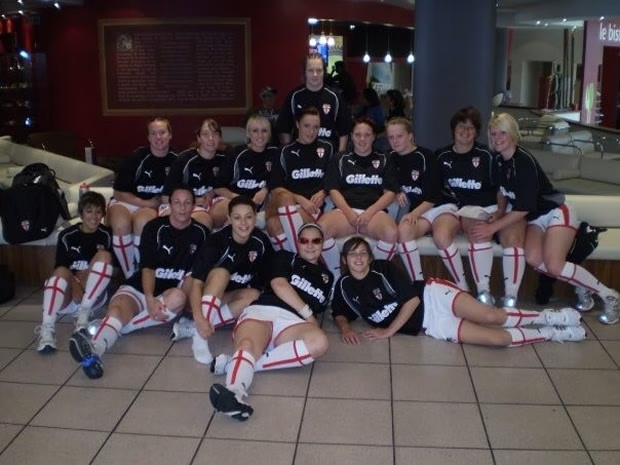
In 2003, following five international campaigns by the Great Britain Women’s Team, the Rugby Football League (RFL) decided to redirect its resources toward the domestic development of the women’s and girls’ game.
As a result, funding for Great Britain representative tours ceased, and the Great Britain Women’s Team was disbanded after 2003.
Part of the £29 million Sport England investment was allocated to integrate the women’s international game into the Rugby League Performance Department, aligning it with the men’s game, which had already transitioned from the Great Britain structure to four separate nations — England, Scotland, Ireland, and Wales.
In 2007, England Women played their first international match against France under this new structure. For the first time, the team received support in sports science, medicine, and performance services, and players no longer had to fund their own participation to represent their country.
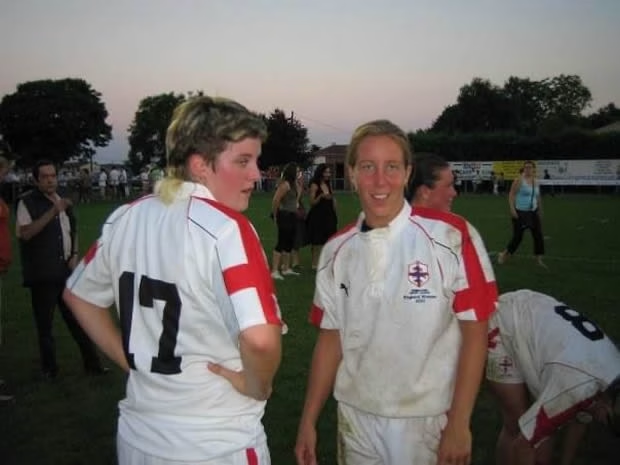
The Rugby Football League (RFL) secured £29 million in funding to grow and develop the sport — a significant investment in its future.
As part of this initiative, the women’s and girls’ game was to be fully integrated into the RFL’s governance structure, ensuring strategic support, dedicated resources, and long-term development pathways across all levels of the sport.
To support this growth, the National Female Steering Group was established as a subgroup of the RFL Community Board, with Pat Crawshaw appointed as the Independent Chair*.
The group’s main purpose was to coordinate the development of the female game, bringing together all areas — including the Women’s Rugby League Association (WRLA), Girls Rugby League Association (GRLA), Combined Services, students, and schools — under a single, unified body.
For the first time, there were both ambitious plans and the resources to drive real progress, particularly in the girls’ game.
Development Officers were recruited across England with a remit to expand the Girls’ Champion Schools competition, organize festivals, and support women’s and girls’ rugby at all levels.
Partnerships were also developed with professional clubs to encourage them to take greater responsibility for advancing the female game.
*Pat Crawshaw, one of the pioneering amateur club and league secretaries, had previously served as a BARLA Board member and as the Community Board representative for Student Rugby League.

The Women’s Rugby League Association (WRLA) continued to be volunteer-led, managing its competitions as a member of the British Amateur Rugby League Association (BARLA).
The league reached its peak during the 2005–2006 season, with 21 teams across three divisions.
Participation generally remained steady until the Rugby Football League (RFL) assumed administration of the community game in 2012, introducing a March-to-October season to take advantage of better weather.
This shift caused many community teams to move, and the WRLA was unable to regain its previous numbers.
WRLA also boasts a long-running Women’s Challenge Cup competition, which began in 1989 at Rochdale Mayfield, with Crosfield Ladies (Warrington) defeating Halifax Ladies 24–18 in the inaugural final.
The competition was hosted for many years by professional clubs, including Dewsbury, Batley, and Keighley, before finding a permanent home at Featherstone Rovers in 2003.
The Cup is traditionally held over the Easter weekend and has regularly attracted strong crowds, highlighting the enduring support for the women’s game.
In 2012, the Rugby Football League (RFL) established its own Women’s Challenge Cup to run alongside the men’s competition.
The aim was to provide women’s rugby league teams with more competitive games and raise the sport’s profile by linking it to the prestigious Challenge Cup. In its early years, most participating teams were community clubs.
By 2021, entry to the competition was restricted to the ten teams in the Women’s Super League, with the number of teams expanding to 16 the following year.
The 2022 final was held as part of a triple-header at Wembley Stadium, highlighting the growing prominence of the women’s game.

After a successful tour of Australia in 2002, Great Britain travelled to New Zealand to compete in the World Cup. It was a younger, developing team, drawn largely from the under-21 squad that had toured Russia a few years earlier.
Great Britain Women’s Rugby League Tours (1996–2003)
Between 1996 and 2003, the Great Britain women’s rugby league team completed five major international tours and tournaments:
1996 – Australia
1998 – New Zealand
2000 – Women’s Rugby League World Series
2002 – Australia
2003 – New Zealand (2nd Women’s World Cup)
For each of these tours, the players themselves were responsible for raising the majority of the necessary funds, with the Rugby Football League (RFL) providing only limited financial support.
In 2003, the Rugby Football League (RFL) redirected the limited funding previously allocated to the Great Britain Women’s Team into the broader development of the women’s and girls’ game.
This decision was a major setback for Head Coach Jackie Sheldon, the volunteers, and the players.
After eight years of personal sacrifice and raising over £400,000 through fundraising efforts, the lack of recognition proved to be the final blow, and the team ultimately disbanded
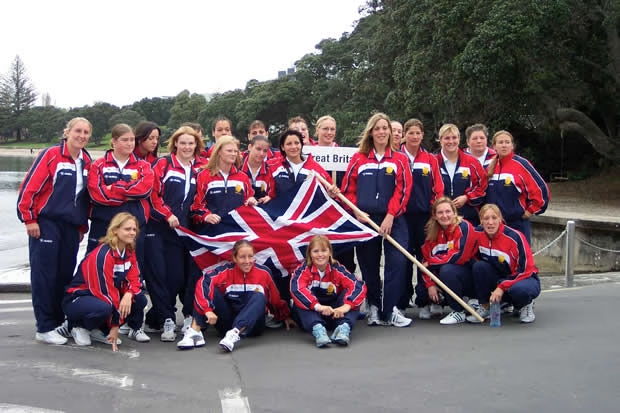
The National Champion Secondary Schools Competition was relaunched to include girls’ teams across all age groups, marking a major step forward in providing structured, competitive opportunities for young female players and strengthening the grassroots foundation of the women’s game.
Champion Schools is the Rugby Football League’s flagship schools competition and remains the world’s largest rugby league knockout tournament.
.
Open to all secondary schools across England and Wales, the competition was relaunched in 2002 and has since featured hundreds of schools and thousands of young players, helping to develop the sport’s next generation across the country.
The tournament has continued to grow in stature, providing opportunities for both boys and girls to experience rugby league and progress from local to regional and ultimately national levels.
A highlight of the competition is the Year 7 Boys’ Final, traditionally held at Wembley Stadium, while the Year 10 Girls now have a standalone final, first introduced in 2023 and staged at the Magic Weekend at St James’ Park

After a successful World Cup in 2000, which was supported by a development programme aimed at increasing the number of women and girls participating in the sport, an under-21 team was formed to nurture emerging players.
The team was coached by Great Britain players Lisa McIntosh and Sam Bailey. To further develop these players, the team toured Russia.

The first international women’s rugby league competition took place in 2000.
Originally called the World Series, it has since been recognised as the first Women’s World Cup. The competition was held in England and was won by New Zealand in front of an audience of 1,262 people.
The first international women’s rugby league competition took place in 2000.
Originally called the World Series, it has since been recognised as the first Women’s World Cup. The competition was held in England and was won by New Zealand in front of an audience of 1,262 people.
One of the pioneers of international women’s rugby league was Jackie Sheldon.
She served as assistant coach of the 1996 touring team and as head coach in 1998 (New Zealand), 2000 (World Series), 2002 (Australia), and 2003 (New Zealand, 2nd World Cup).
Her innovative approaches to training and player development were often more advanced than those used by her male counterparts.
Underpinning the 2000 Women’s Rugby League World Series was a dedicated programme aimed at developing more girls’ teams across the country.
This initiative led to the reformation of the Girls Rugby League Association, supported by funding from the Awards for All grant scheme.
The programme resulted in a significant increase in girls’ participation in rugby league, laying the foundations for future growth in the women’s game.

Jackie Sheldon was the first Women’s Rugby League Development Officer, taking on the role in 1997 to spearhead the development of the women’s game.
She was also the first woman to achieve the RFL’s Level 4 Coaching Certificate and was instrumental in coaching the Great Britain team on tours, which helped grow the sport significantly.
Her efforts in the mid-1990s led to a rise in participation and the establishment of new girls’ teams

The 1996 coaching team consisted of Ian Harris (head coach) and Jackie Sheldon (assistant).
They employed a very modern approach, pioneering techniques and coaching methods that were ahead of their time, and even used a sports psychologist.
Through fundraising activities such as bucket collections and race nights, they raised over £50,000.
The team won five of their six fixtures, becoming one of the most successful UK international sides.
However, upon their return, their achievements were largely ignored, both internationally and by the Rugby Football League.
Their accomplishments were finally recognized in 2024, when the team became the first to be inducted into the Rugby League Hall of Fame.
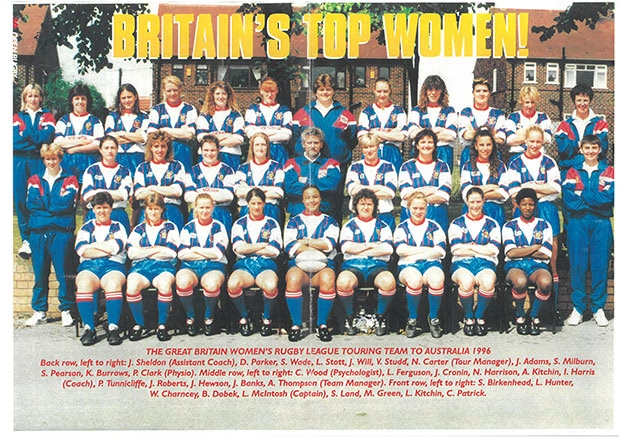
From the birth of rugby league, women have always played an active role in the game (see the pre-1980s section for more information). Their involvement included playing informally on the streets, supporting the men’s game as spectators and fundraisers, and playing a pivotal role in schools by encouraging boys to take up rugby league.
During the 1980s, supported by Sports Council campaigns, more women began undertaking coaching awards and subsequently coaching youth and junior teams.
In the 1990s, an increasing number of women took on coaching and leadership roles. Brenda Dobek, Jackie Sheldon, and Anne Thompson began coaching their women’s teams in the early part of the decade.
In 1995, Jackie Sheldon became the first woman to achieve a Level 4 coaching award—the highest qualification in the game at that time.
She was passionate about encouraging other women to follow in her footsteps and supported Brenda Dobek, Jane Banks, Chantel Patrick, and Lisa McIntosh through the three-year Getting into High Performance Coaching programme developed by the Women’s Sport Foundation.
Since then, progress has been gradual, with most women continuing to coach at youth and junior levels.
However, in today’s women’s game, several highly successful team have women as head coaches, including Lois Forsell (Leeds Rhinos), Lindsay Anfield (York Valkyrie), and Amanda Wilkinson (Barrow Raiders).
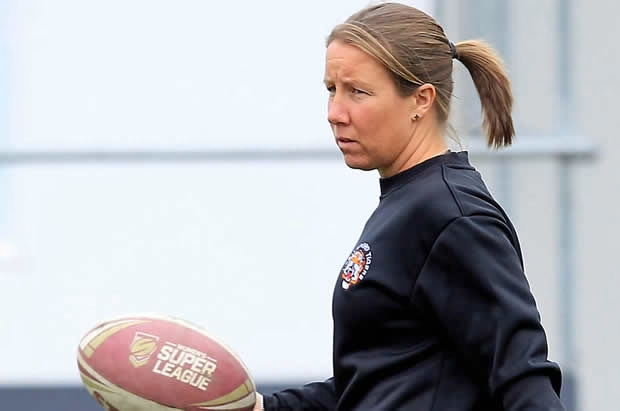
Places like Halifax, Bradford, Leeds, Rochdale, Wakefield, Barrow and Hull became important centres for development with several competing teams.
Dudley Hill (Bradford) and Wakefield were particularly dominant, with the latter being almost unbeatable for long periods of time in the 1990s.
Early women’s rugby league was usually played in challenging conditions.
Many clubs received little to no funding, with players and administrators paying for everything.
This meant that matches generally took place on council playing fields or other grounds lacking basic facilities. As a winter sport, pitches were often very muddy and waterlogged.
Another practical challenge was the kit. Because the women’s game was played away from the spotlight, manufacturers did not consider producing things designed for women.
Some teams used old men’s kits to save money, or borrowed from family members. The lack of specially-designed kits for women remains a challenge today.
Early women’s rugby league clubs sometimes had to move around (and change names) to keep playing.
One example was Widnes, where many of their players had to move to continue to play.
Widnes became ‘Wigan St Patricks’, and then ‘Hindley’
WiRL has faced many challenges in finding accurate fixtures and results for each season.
In the archive, we have a jigsaw puzzle of information that will take a considerable amount of work to piece together so we can accurately report season by season.

Led by Anne Thompson and Jackie Sheldon, they organised a one-day event in Shelf, near Wakefield, for the women’s clubs to shape the direction of the women’s and girls’ game.
They secured funding from the Sports Council and appointed Celia Brackenridge, founder of the Women’s Sport Foundation, as a facilitator.
A day was spent developing the ideas in the room to shape the next steps in the development of women and girls rugby league
The first Women’s and Girls’ Development Plan was created; however, it was not received positively by all WARLA members, and the process resulted in some men on the committee resigning.

In the early 1990s, Women’s Amateur Rugby League (WARLA) was accepted as an associate member of the British Amateur Rugby League (BARLA).
At the time, Rugby League Development Officers were encouraged to support the growth of the girls’ and women’s game.
A Girls Rugby League Association was formed, which led to an increase in girls’ participation at both club and county levels. However, the association failed to gain sustained momentum and was not revived until 2000.
Girls who wanted to play often joined boys’ teams, sometimes continuing into their late teens, and some girls as young as 11 played for open-age women’s teams.
In the mid-1990s, girls were prohibited from playing with boys from the age of 12 due to concerns over physical development and safety.
This frequently left girls with no opportunities to play until they reached 16 years of age.
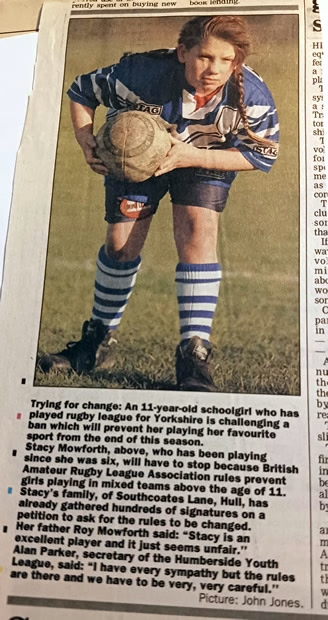
In the early 1990s, Women’s Amateur Rugby League (WARLA) was accepted as an associate member of the British Amateur Rugby League (BARLA). The Rugby Football League took over the administration of the sport in 2012.
The original women’s association had used the term ‘ladies’ but in 1990, that was changed to ‘women’.
In 1997, it was renamed once more to Women’s Rugby League Association with a dynamic logo that is still used to this day.
As with most amateur associations of its time, it had a formal constitution and an AGM was held every year, offering a chance for the women’s teams to come together to make key decisions, such as when it was agreed to change from the ‘Ladies’ to the ‘Women’s’ association.
As the women’s game grew, WARLA met monthly to administrate the games and ensure that discipline was managed, dealing with on and off-field disputes.
An annual awards night was established to celebrate the achievements of players and clubs.
The first recorded event took place in Halifax in 1989. The event later moved to the west coast, becoming a well-attended and much-anticipated weekend occasion, initially held in Morecambe, then subsequently in Blackpool.

County games began in the 1990s, with Yorkshire and Lancashire often competing, and for a few seasons, Cumbria also fielded a team.
Women’s rugby league matches were sometimes played in larger stadiums such as Old Trafford (Greater Manchester) or club grounds such as Halifax RLFC, Keighley, or Castleford RLFC.
However, these games were usually billed as additional entertainment for men’s fixtures, often played either at half-time, playing reduced time, or beforehand as curtain raisers.

In 1989, the first English women’s rugby league tour went to France. With no female teams to play, they faced a boys’ U17 side and even filled out the opposition in France v Great Britain in Perpignan— a testament to their determination and the lack of women’s competition at the time.

In the January mud and rain, the first women’s Challenge Cup final was between Crosfield Ladies (Warrington) and Halifax Ladies. Crosfield beat Halifax 24 points to 18.
Halifax’s Lindsey England was awarded player of the match.
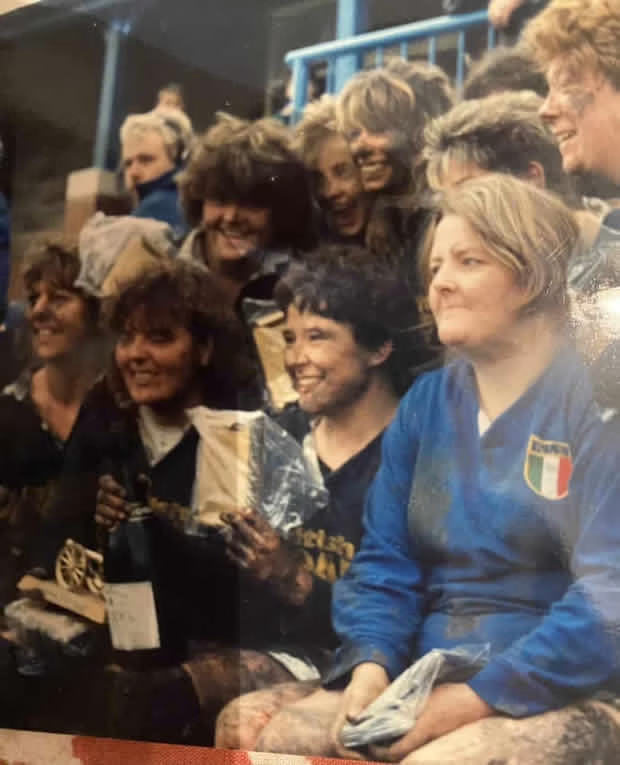
A breakthrough tournament for the national game was the British Coal (the sponsor) nine-a-side tournament, which was run alongside the men’s game.
Tapping into growing popularity in women’s rugby league, it gave the sport a huge boost with proper venues, resources and exposure.
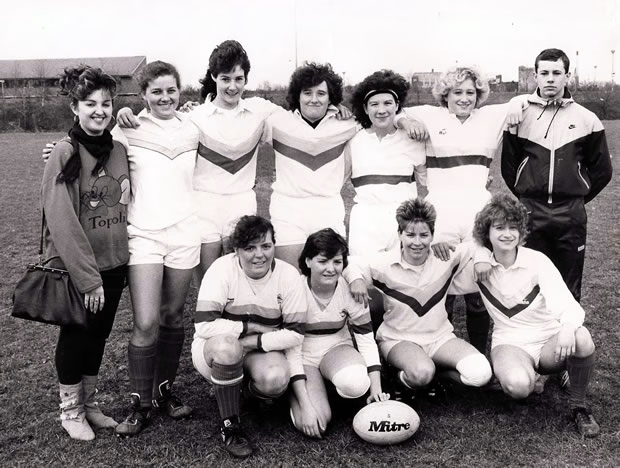
The Ladies Amateur Rugby League Association (LARLA) first fixtures where to be played 17 November 1985 with the intention of playing 16 fixtures. The founder members were:
The game initially began as a nine-a-side competition. In the mid-1990s, it transitioned to the traditional 13-a-side format to facilitate the completion of fixtures. Additionally, pre-season seven-a-side competitions were introduced to encourage greater participation.
The Ladies Amateur Rugby League Association’s role was to run the women’s game. They organised league and knockout competitions, decided on rules and structures and supported the development of the game. Representatives of each team would meet regularly to make key decisions. Everyone was a volunteer.
The No. 7 Shield trophy was donated by a businessman from Keighley. It was later known as the Anne Gibson Aggregate Cup and was contested alongside the Women’s Challenge Cup until the late 1990s.

Women who wanted to take up refereeing were not initially welcomed, as it was seen as a male domain.
Clubs also lacked appropriate changing facilities to accommodate women.
Like all beginners, women started at the junior or youth matches, but many found it difficult to progress on to officiating open-age matches.
Due to personal circumstances, Julia Lee moved to London, where there was no junior or youth rugby league. As a result, after only a few months of officiating, she became the first woman to referee men’s rugby league.
There was no formal training at the time, so both women and men were often simply given a copy of the Laws of the Game and sent out to officiate with little preparation.
Referee societies frequently met in male-only working men’s clubs and held men-only events.
The referee kit was designed for men, and if teams had not seen you officiate before, it was often assumed to be your first game—verbal abuse was commonplace.
Julia Lee was determined to learn from her own experiences of struggling to understand the interpretations of the laws of the game and the limited support available to her.
In the early 1990s, she joined forces with Jean Horseman, a Rhinos fan and activist, and fellow referee Rachel Timson to establish the National Women’s Referee Association.
The Association developed both practical and theoretical refereeing training to encourage more women to take up the whistle, and within a few years successfully recruited over 40 female match officials.
Despite the early encouraging signs for female officials in the 1980s and 1990s, it took nearly 40 years for women to make significant progress. In 2024, Tara Jones became the first professional match official, marking a milestone alongside the growing number of female officials now active at all levels of the game.
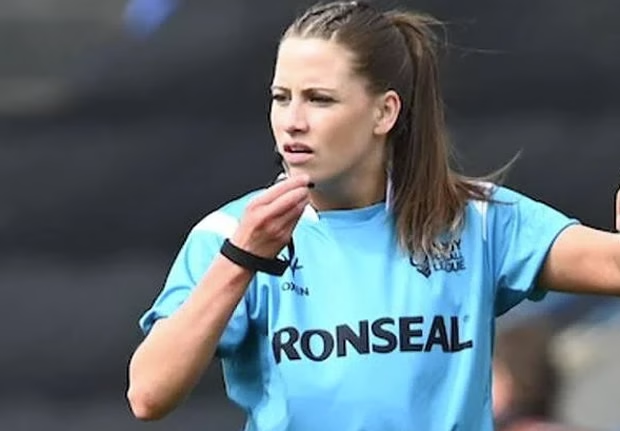
A Festival of Sport, held in Askham village in Cumbria (near the Scottish border), featured a four-team tournament playing 13 aside, which was turned into a league.
Those first Cumbrian teams were Ulverston Wildcats, Barrow Island Tigers, Askham Harlequins and Dalton.
A team from nearby Millon Leopards joined in 1983.
Only Ulverston Wildcats were still playing a couple of years later but many more were inspired to set up across the north of England, mainly in the traditional rugby league centres.
In 1983 Granada TV featured them in a documentary.
This story had been forgotten until the Women in Rugby League project interviewed Mary McPortland, who played for Ulverston Wildcats.

From 1990 Huddersfield Supporters team played friendlies and charity matches over a four-year period before they joined the league in 1985
Guiseley, from Leeds, took on the men’s team who amusingly turned out wearing wellies — providing plenty of entertainment for the crowd.
In York, a special charity match was held to raise funds for a baby scanner, drawing strong community support and showcasing the generous spirit of local sport.

